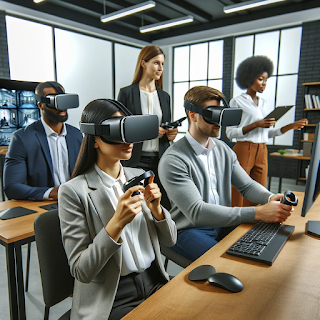Virtual reality (VR) and augmented reality (AR): Immersive technologies that make experiences more interesting
In the fast-paced world of business-to-business (B2B) marketing, it's important to keep up with the latest tech trends. Augmented reality (AR) and virtual reality (VR) are at the center of this change, providing new ways to make content experiences that are more engaging. These technologies are changing more than just pleasure. They are also changing how companies talk to, teach, and interact with their customers.
How VR and AR are Changing Business
VR and AR are now useful tools in the business-to-business (B2B) world, not just for games and enjoyment. Their skill at making experiences that are highly interesting and interactive is unmatched. AR adds digital information to the real world to make it better, while VR puts people in a completely digital world. Businesses can do a huge range of things with this mix of real and virtual places.
Changes being made to training and communication
One of the most important ways that VR and AR are used in business is for teaching and communication. These technologies make it possible to make models and settings that feel real, which is great for training and improving skills. For instance, VR can be used to train people in real-life situations without the risks or costs that come with them. AR, on the other hand, can give knowledge and help in real time, which makes learning better.
Making sales and marketing better
VR and AR offer new ways to show off goods and services in marketing and sales. Businesses can give more interesting virtual tours, product demos, and interactive experiences with immersive content and 360 movies compared to the old ways. This not only makes it easier to see the goods, but it also makes the experience memorable, which can affect the choice to buy.
Getting customers more involved
For B2B marketing to work, it's important to keep customers interested. VR and AR can take this to the next level. Customers will enjoy unique and collaborative experiences made possible by these technologies. AR apps can make catalogs and ads come to life, for example, so buyers can interact with goods in their own surroundings. In the same way, VR can be used to make virtual events or displays, which can give customers a more immersive experience that can help build connections with them.
What Immersive Content Can Do for You
Making engaging material that people want to watch or listen to is key to using VR and AR to their full potential. This material should not only look great, but it should also be useful and relevant to the audience. 360-degree movies, for example, can make people feel like they are really there, which regular videos can't do. This amount of involvement can make people much more aware of and loyal to a brand.
Telling Stories in a New Way
With immersive material, stories can be told in a whole new way. Businesses can tell their stories in a more involved and interesting way with VR and AR, which helps them connect with their audience on a deeper emotional level. This is a great way to explain complicated ideas or processes in a way that is easy to understand.
Connecting the Real and Digital Worlds
VR and AR fill the space between the real and digital worlds, giving people a new way to experience both. Businesses can come up with new ways to connect with customers and show off their goods and services because of this merging. It also lets you gather useful information about how people use the site and what they like, which can help you make better marketing decisions in the future.
What VR and AR Will Mean for B2B Marketing in the Future
VR and AR have a bright future in B2B marketing as technology keeps getting better. It will get easier and cheaper to use these tools, which will lead to more people using them. The lines between the real and virtual worlds will become even less clear as apps get smarter and more involved.
Getting Used to Change
Businesses that want to stay competitive need to start using VR and AR more and more. To do this, you need to spend money on both technology and the knowledge and skills to make and use engaging content tactics that work. As these technologies get better, they will make it easier to come up with new products and services that stand out in the market.
The Way Ahead
When it comes to B2B marketing, VR and AR still have a long way to go. As companies keep playing around with and improving these technologies, we will see them used in new and interesting ways. There is a lot of room for making experiences that are truly interesting and lasting, and people who take advantage of it will be successful in the digital age.
To sum up, VR and AR are changing the way B2B marketing is done. These technologies give companies strong ways to talk to, teach, and connect with their audiences by creating realistic and interesting experiences. In the future, people who want to be at the top of their fields will have to use VR and AR in their business plans, not just as an option.



